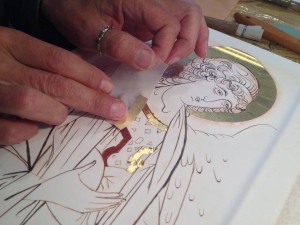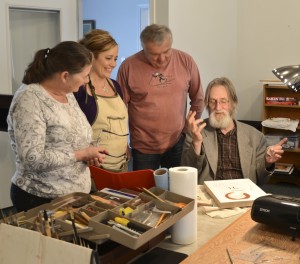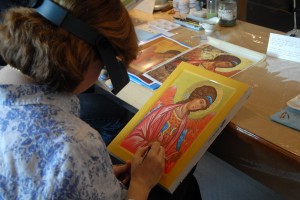Considering all the media and the multiplicity of creative means of expressing yourself artistically, why would someone study Iconography? Whereas most art forms encourage the artist to be creative, iconography does just the opposite. The iconographer strives to reproduce with exactness the icon he is copying. Just as ancient scribes painstakingly strove to copy the Sacred Scriptures without any variation from the original, so also does the iconographer. Why then do people find this work compelling? Is it attractive simply because it has stood the test of time, or has it stood the test of time because it is attractive? In other words, is this just another form of folk art, or is there a greater attraction here?
This past summer, in the Living Water College Iconography Program, Made in His Likeness, not only did students learn how to paint an icon of the glorious St. Michael the Archangel, but, through daily readings and seminars, the students entered into a discussion of beauty itself and what it is that makes the icon so attractive.
Frank Turner, actor, iconographer and Director of Fine Arts instructor at the College, instructed the students in proper technique one layer of paint at a time.
“When teaching iconography I enter into a special realm of existence,” says Frank. “Time becomes elastic and the excitement of passing on this ancient tradition becomes all encompassing.”
He also enjoys guiding students’ understanding of iconography, and how it is different from religious art or decoration.
“The iconographer is more of a conduit than an initiator,” explains Frank. “The forms of the icons have been passed down through generations of iconographers ‘quoting’ earlier work. The icon itself is a means of opening the conversation with the person represented.”
In spite of an initial impression that icons seem stark and unrealistic, the students came to see the profound beauty revealed in the symbolism of these classic images. After the first seminar session they were hooked, and began to eagerly look forward to pausing for two hours each day and discussing profound ideas central to our humanity.
They examined the relationship between beauty and worship, reflecting on the differences they have experienced praying in a sparse modern church as compared to one with beautiful ancient architecture, images and statues. They read the thoughts of St. Augustine, who spoke of the potential distraction caused by beauty, especially when we desire to have “fair forms” satisfy us completely. This caution led to a discussion on the sincere motivation of ancient iconoclasts, who endeavoured to clear the early church of images, and the iconoclasts of post-Vatican II, bent on simplifying and modernizing the decoration of Catholic churches. Study of the works of St. John Damascene, who eloquently challenged the iconoclasm of the 8th century, provided brilliant perspective on the need for beauty in our churches today, with insights such as “Through beauty, the invisible is made visible”.
Maria Cecilia Arango, an art teacher originally from Columbia, was a student in the program.
“It was truly a spiritual experience – very wonderful,” says Maria Cecilia. “Every moment was a delight, and Frank, our teacher, not only taught us the technique but was an example to us of love, service and humility. I discovered that we are all “living icons” that reflect the image of God with our lives and our being.”
Day after day, the students posed rich ideas and grew closer to an understanding of the place of the icon in the worship of God. Discussions and readings likely provided more questions than answers, but the answers they did arrive at were very rewarding. Ultimately, their ideas were borne out in their practice, painstakingly copying Holy Scripture as it is represented by the image, daily more clearly gazing back at them. They thought deeply and seriously, they carefully fashioned a true representation of the classic icon of St. Michael, and they bent their will to God through the whole process, daily taking their work and their thoughts to their community and private prayer and the Holy Sacrifice of the Mass, and daily bringing back to class the rich fruit of the growth in faith these two weeks provided.
Living Water College will be offering a Film Program in July/August 2014: “Truth in Motion”. For more information, visit www.livingwatercollege.com
Instructor Frank Turner on “Iconography: The Technique”:
An interview with Student Cecilia Maria Arango, as she shares her experience of the Iconography 2013 program, and comments on the true meaning and communication of beauty:
A first glance at Living Water College’s Film Program, coming in the summer of 2014:










